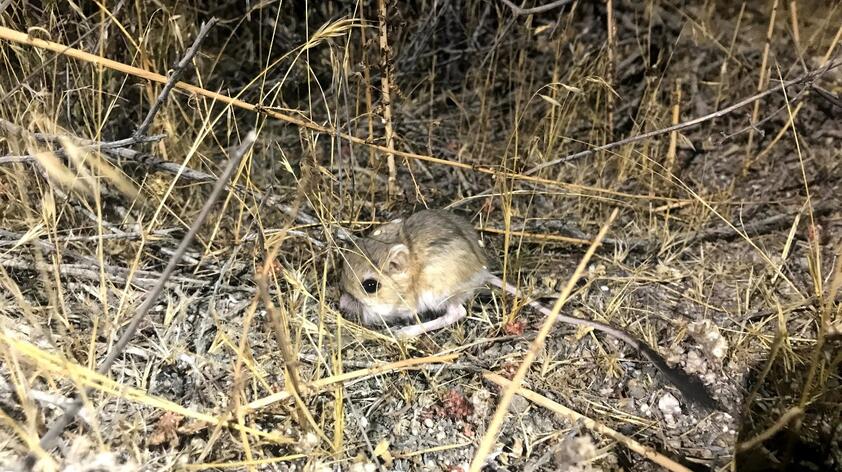
Conserving the underdog: Collaborative efforts to translocate endangered kangaroo rats
Moving nocturnal endangered kangaroo rats out of harm’s way onto conserved land is tricky. They are a prey species and predators at the receiver site may find them before they are able to dig new burrow systems and make it their home. We developed an effective protocol for relocating the endangered Stephens’ kangaroo rat, but attempts to translocate the endangered San Bernardino kangaroo rat (SBKR) haven’t yet been successful. Why? Maybe because they are the smallest and most docile kangaroo rat and in addition to having to deal with predators, larger rodent species that are residents in their new neighborhood “push them around”, preventing them from settling at the receiver site. Or, maybe because they have specific habitat needs that elude us. We took on the challenge this year and set out to give translocation of this at-risk species our best shot.
It took nearly 5 weeks of night trapping at 4 different sites slated for development, but eventually we collected 50. But we couldn’t take everyone; newly emergent pups are unlikely to survive a translocation.
We marked them so that we could tell who was who, got to know individuals by doing personality assessments and fitted everyone that was big enough with a radio transmitter so that we could track their movements and determine their fates after transfer to their new home. In the meantime, the landowner and manager of the receiver site, Riverside Conservation Authority made the site even more appealing for SBKR by thinning the shrubs and removing nonnative grasses.
We then we set up acclimation chambers at the receiver site to encourage them to settle. Acclimation chambers are like new two-story furnished apartments—they have an above-ground chamber filled with dirt for sandbathing and seed for caching and a below ground “bedroom” filled with nesting material for sleeping during the day. One for everyone since kangaroo rats are solitary, like tiny pandas.
Once the receiver site was prepared, we collected everyone from their holding chambers and transported them to the receiver site.
With the help of our collaborators at California Department of Fish and Wildlife, Riverside Conservation Authority, and San Bernardino Valley Water Conservation District, we transferred them to their new digs.
We fed them for nearly a week, then we removed the top portion and spread sand from each individual temporary enclosure around their acclimation cage to make them feel at home, tossed seed around the site to encourage them to stay, and starting tracking their movements.
Our team took shifts and tracked them three times a week. We found them in their sleep burrows just before sunset and then one to two more times when they were active during the night. Much to our delight, most of them settled in the area of the site fairly quickly. They moved about during the night, almost always returning to their same day burrows to sleep. We trapped for a night two weeks later to make sure everyone was tolerating their transmitters and remained in good body condition. After a month it was time to remove the transmitters, which meant getting them in traps last week. We set 10 traps around each individual’s day burrow and removed 16 transmitters on the first night. By the fifth night we had removed all of the transmitters except for one: little male 'gold/white' refused to go into the traps, even though we had increased the number of traps around his day burrow to 20! So, we made it our mission on Friday night to get him one way or another. I brought nets, a large towel, a camping chair, night vision googles and a big jacket.
Dusk falls early this time of year, so traps were set by 5 p.m. and we returned to the site at 9 p.m. to see if we got lucky. We didn’t. Almost every trap was occupied, but not by 'gold/white'. We tracked him to his day burrow and then set up camping chairs and observed his burrow entrances through our night vision googles for an hour, but he never made an appearance. We released everyone else from the traps and moved away from his day burrow area for a little while to give him time to come above ground. When we returned, we tracked him to a sage bush just next to his burrow. He blended in perfectly with his tawny brown fur but the reflective tape on his ear tag gave him away. We surrounded the bush and began to crawl towards each other. He sat at the very center of the bush and occasionally darted towards one of us. If he got past, we knew it was over. We tried to grab him by hand but he was fast! Finally, on my belly in the cold dirt, I managed to grab his transmitter antennae and gently bring him to my chest. Success! I removed the transmitter and he hung out on my arm for a photo before heading back toward his burrow.
All together we captured 38 of our SBKR 1 month post-translocation with at least another 3 that were likely still on site but had slipped their transmitters a few days before trapping. A truly successful end to our fall translocation efforts. We’ll continue supplementing the site with seed and keep our fingers crossed that they make it through the winter.













